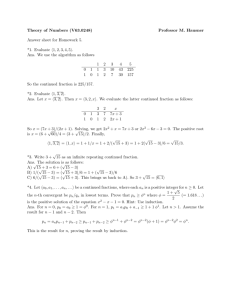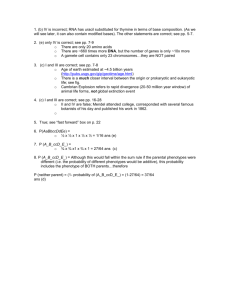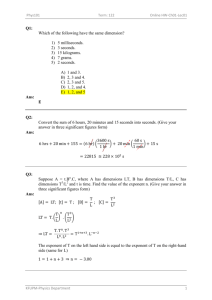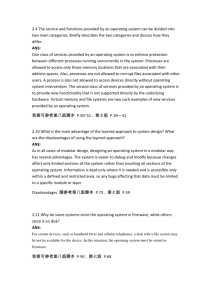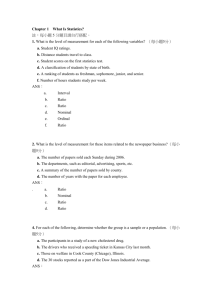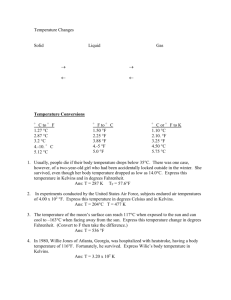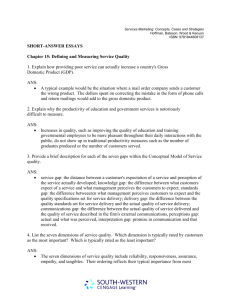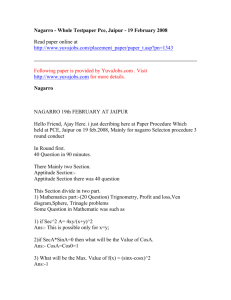Module-8
advertisement
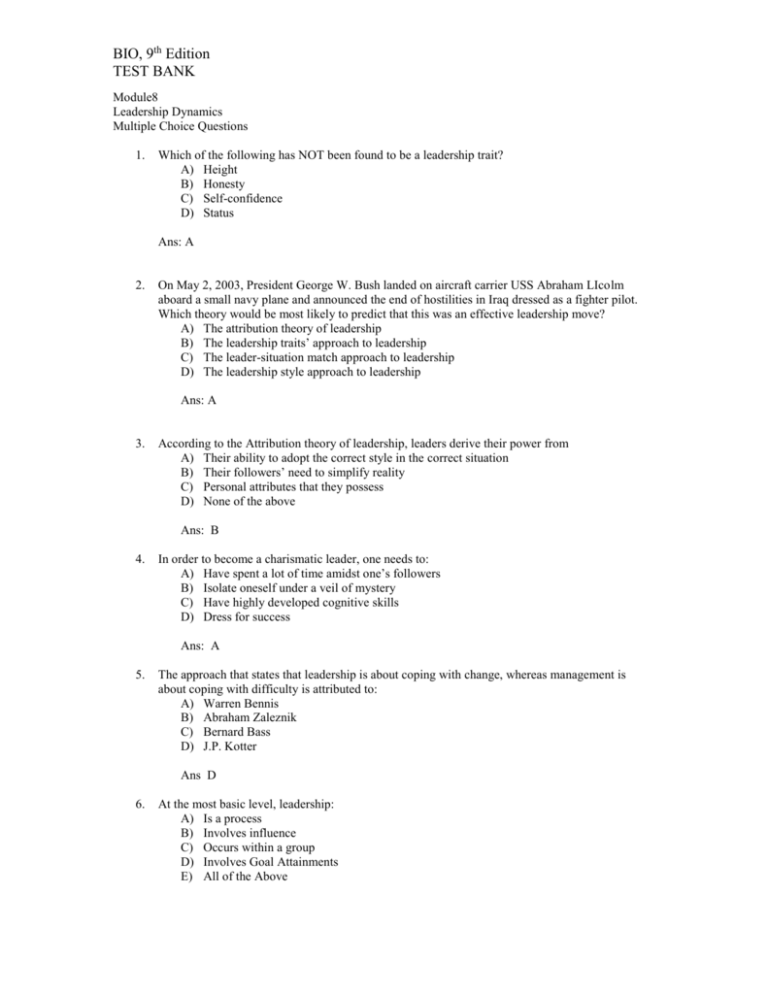
BIO, 9th Edition TEST BANK Module8 Leadership Dynamics Multiple Choice Questions 1. Which of the following has NOT been found to be a leadership trait? A) Height B) Honesty C) Self-confidence D) Status Ans: A 2. On May 2, 2003, President George W. Bush landed on aircraft carrier USS Abraham LIcolm aboard a small navy plane and announced the end of hostilities in Iraq dressed as a fighter pilot. Which theory would be most likely to predict that this was an effective leadership move? A) The attribution theory of leadership B) The leadership traits’ approach to leadership C) The leader-situation match approach to leadership D) The leadership style approach to leadership Ans: A 3. According to the Attribution theory of leadership, leaders derive their power from A) Their ability to adopt the correct style in the correct situation B) Their followers’ need to simplify reality C) Personal attributes that they possess D) None of the above Ans: B 4. In order to become a charismatic leader, one needs to: A) Have spent a lot of time amidst one’s followers B) Isolate oneself under a veil of mystery C) Have highly developed cognitive skills D) Dress for success Ans: A 5. The approach that states that leadership is about coping with change, whereas management is about coping with difficulty is attributed to: A) Warren Bennis B) Abraham Zaleznik C) Bernard Bass D) J.P. Kotter Ans D 6. At the most basic level, leadership: A) Is a process B) Involves influence C) Occurs within a group D) Involves Goal Attainments E) All of the Above BIO, 9th Edition TEST BANK Ans: E 7. Goleman’s basic argument is that “Primal Leadership” operates best through: A) Emotional intelligent workers B) Emotional intelligent leaders who create response C) Situations in which leaders follow a participative style D) The enthusiasm generated by employees Ans: B 8. The leadership ladder concept attempts to capture: A) The challenges that managers face at work B) The outcomes of the 360 degree feedback leader profile C) The notion that distinct core behaviors and competencies can be identified at each level of the managerial hierarchy D) The role that expectations play at each level of the managerial hierarchy Ans: C 10. Which of the following skills are helpful in all leadership positions? A) analytical ability B) persuasiveness C) memory for detail D) tact and empathy E) all of the above Answer: E 11. Which of the following models strive to design a managerial position to match the motivational and personality characteristics of a manager? A) Leadership Behavior Model B) Path-Goal Model C) Fieldler's Contingency Model D) Task Behavior Model Answer: C 12. The situational leadership model developed by Hersey and Blanchard is widely used in corporate training, the military and other government agencies in the United States. This model emphasizes, A) task behavior B) relationship behavior C) consideration D) all of the above Answer: D 13. The most dramatic shift away from Fiedler's contingency theory suggests A) leadership style is fixed B) managers determine how best to change aspects of the work situation C) managers determine that there must be a change in leaders D) managers guide subordinates towards improved performance and satisfaction Answer: A 14. As the challenges of managing and leading increase, so does our need to understand BIO, 9th Edition TEST BANK A) B) C) D) the unique features of leaders the leadership process managerial and leadership dynamics in the context of organizational behavior all of the above Answer: D 15. How can a manager best influence others to bring about change? A) increase interest in leadership B) explore tenets of organizational effectiveness C) open discussion of weaknesses D) emphasize the exercise of acquired skills Answer: B 16. Yukl notes that most definitions of leadership emphasize A) commitment B) influence process C) behavior D) natural instincts Answer: B 17. Which of the following famous leadership scholars said this, “Leaders manage and managers lead, but the two activities are not synonymous.”? A) Bernard Bass B) Abraham Zaleznik C) Warren Bennis D) None of the above Answer: A 18. Because not everyone is willing to accept the responsibilities and burdens of leadership, leadership is a A) natural instinct B) intentional act C) skill and trade D) all of the above Answer: B 19. The leadership tactics that may work in the military may not work in a software company, much like those that work in a factory may not work at a university. This concept refers to A) leadership traits B) leadership culture C) leadership style D) role behaviors Answer: C 20. The highly directive involvement by management and a strongly conforming involvement of employees is indication of this leadership style A) family style B) autocratic style C) team style D) none of the above BIO, 9th Edition TEST BANK Answer: B 21. Project Globe identified 22 specific attributes that contribute to leadership effectiveness. This research was unique in that A) it determined that many attributes of leadership are culturally dependent B) it determined that many attributes and behaviors are accepted universally C) it determined that some attributes or behaviors are viewed as impediments to leadership effectiveness D) all of the above Answer: D 22. Goldman basic argument is that “primal leadership” operates best through A) emotional intelligent workers B) emotional intelligent leaders who create resonance C) situations in which leaders follow a participative style D) the enthusiasm generated by employees Answer: B 23. The emerging school of though that centers on emotional intelligence argues that A) EQ is at the center of human behavior B) EI is a core variable that effects the performance of leaders C) EQ is a core variable that effects the behavior of employees D) EI is the process of human interaction Answer: B 24. The leadership ladder concept attempts to capture A) the challenges that managers face at work B) the outcomes of the 360-degree feedback leader profile C) the notion that distinct core behaviors and competencies can be identified at each level of the managerial hierarchy D) the role that expectations play at each level of the managerial hierarchy Answer: C BIO, 9th Edition TEST BANK Module 8 Leadership Dynamics True/False Questions 24.The systematic study of leadership and management has been around sicne antiquity. Ans: False 25.Managers and leaders differ in what they attend to and in how they think, work, and interact. Ans: True 26.Transformational leaders often perform the roles of coach, trainer, and mentor. Ans: True 27. No one is able to perceive the world with complete objectivity. Answer: True Page: 282 Difficulty: Easy 28. Stereotypes fulfill the needs of people and are major communication problems in organizing life. Answer: True Page: 282 Difficulty: Medium 29. Management research has found very few perceptual differences among individuals at different levels of the managerial hierarchy. Answer: False Page: 281 Difficulty: Medium 30. The attribution process provides insights into the understanding of individual behavior, including ourselves. Answer: False Page: 280 Difficulty: Medium 31. According to attribution theory, it is the perceived cause of events, not the actual events that influence individual's behavior. Answer: True Page: 280 Difficulty: Hard 32. Managers generally pride themselves on their ability and objectivity when judging people. Answer: True Page: 279 Difficulty: Medium 33. Older workers are more accident prone than their younger colleagues. Answer: False Page: 277 Difficulty: Medium 34. American females perceive that males and females were equally likely to possess traits necessary for managerial success. Answer: True Page: 277 Difficulty: Easy 35. If you are a fearful person, you may perceive everything that happens in negative terms. Answer: True Page: 276 Difficulty: Medium BIO, 9th Edition TEST BANK 36. An individual with strong status needs may claim he/she wants public recognition for their work and effort. Answer: False Page: 276 Difficulty: Hard 37. Stereotyping is a negative process. Answer: False Page: 276 Difficulty: Hard 38. Objects, events, or social interactions that arouse fears or concerns in an individual are often dealt with psychologically in a manner of which the individual is unaware. Answer: True Page: Difficulty: Hard 39. Feelings and emotions affect your perceptions all the time, even though you may not be aware of it. Answer: True Page: Difficulty: Hard 40. The overlap between the coding systems of people with similar experiences is a fundamental requirement of communication. Answer: True Page: Difficulty: Medium 41. It is impossible to separate physiological and psychological factors. Answer: True Page: Difficulty: Hard 42. Many subtle differences between people exist and influence how they see things, but there may be no awareness of the physiological factors that account for the differences. Answer: True Page: Difficulty: Medium 43. Society is a complex system of expectations that exists in each person's brain of how people should, ought, and must behave under both general and specific circumstances. Answer: True Page: Difficulty: Easy 44. It is critical for managers to understand the perceptual process and the potential barriers to accurate perception. Answer: True Page: Difficulty: Medium 45. Perception is an active process by which individuals screen, select, and organize stimuli. Answer: True Page: Difficulty: Medium 46. Perception and attribution provide a framework and a useful tool for understanding effectiveness at the individual, group, intergroup, and organizational levels. Answer: True Page: Difficulty: Medium
